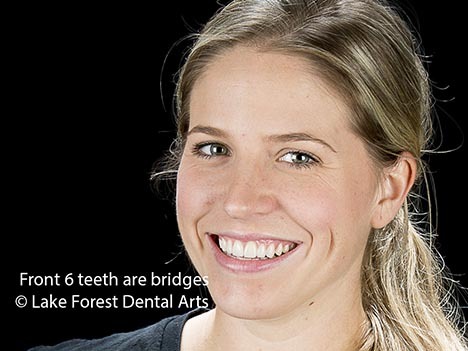
Technically, your permanent teeth should last a lifetime. Realistically, however, that isn’t always the case. Tooth loss can affect anyone, given the right circumstances. With its astounding prevalence (statistics show that 69% of adults aged 35-44 have lost at least one permanent tooth), you might wonder if tooth loss is preventable at all. By understanding how it happens, you can increase your chances of keeping all of your natural teeth. By knowing what to do if you lose one or more teeth, you can protect your smile from suffering the effects of tooth loss.
How to Replace Teeth
DENTAL BRIDGES & DENTURES
How you replace your lost teeth depends on how many teeth you’ve lost, and where they were in relation to your other teeth. For a single lost tooth or a few lost teeth in a row, Dr. Fondriest may recommend a dental bridge to fill the gap in your smile. If you’ve lost more than one tooth and they’re not adjacent to each other, then a partial denture can be designed to fit around your existing teeth while filling in the gaps. A full denture is comprised of an entire row of teeth situated on a gum-colored base and can restore your smile when you’ve lost all of your teeth on one or both dental ridges.
How Bridges Work
Dental bridges rely on a combination of crowns and a prosthetic tooth, such as a partial denture, to bridge the gap created by a lost tooth or teeth. By securing the prosthetic to crowns, which are affixed to your teeth adjacent to the gap, a dental bridge provides a stable way to complete a smile and one that allows patients to chew and speak confidently. Even if you’re not highly concerned with the look of your smile after the loss of a tooth, prompt treatment is recommended to prevent your other teeth from shifting into the created gap. Replacing a tooth also makes it easier to chew as you normally would, without needing to avoid certain areas of your mouth.
Dental bridges are more stable than using adhesives, but also take less time to complete than dental implants, making them an ideal choice for many patients. Although, dental bridges can be anchored by dental implants if you have lost several teeth.
DENTAL IMPLANTS
Unlike a bridge or denture, a dental implant is surgically inserted into your jawbone to replace the roots of your lost teeth. After your jawbone has healed, which typically lasts about 4-6 months, Dr. Fondriest can attach your dental prosthetic to the implants for increased stability and support. Dental implants also help keep your jawbone strong by facilitating a healthy flow of blood to your jaw when the devices are stimulated by biting and chewing.

woman with dental bridges
Learn how to replace lost teeth
Aside from providing expert cosmetic dentistry services to our community, Dr. James Fondriest also holds highly-respected academic appointments at the Pankey Institute in Key Biscayne, FL, and the Spear Institute in Scottsdale, AZ, and he is an Adjunct Associate Professor in the Department of Prosthodontics at the University of Florida Dental School. Dr. Fondriest combines his impressive array of experience with modern technology and caring, compassionate, and knowledgeable staff, and we proudly serve serve the Chicago metropolitan area including the North Shore and Northwest suburbs. To schedule your consultation, call our office today at (847) 234-0517.
How teeth are lost
GUM DISEASE
More formally known as periodontal disease, gum disease progresses through several stages when allowed to run rampant. Its most severe stage, called periodontitis, involves the destruction of the gums and jawbone that support your teeth. The early stage of gum disease, or gingivitis, doesn’t usually generate discomfort, and many patients neglect to seek treatment before the disease ravishes their teeth’s support.
SEVERE CAVITIES
A tooth infection, or tooth decay, results when bacteria infect your tooth’s main structure. As the infection spreads, cavities (holes) develop and grow larger until the infection reaches the nerves and blood vessels at the center of the tooth. In severe cases, cavities can completely consume a tooth, causing it to fall out or need an extraction.
How to Keep Your Teeth
HOME HYGIENE
Since gum disease and cavities are the most common reasons for tooth loss, preventing them from forming is the most effective means of preventing tooth loss. Both dental infections are a product of excessive bacteria, which can be found abundantly in dental plaque. Brushing and flossing your teeth at least twice a day helps control oral bacteria and plaque buildup and reduces your risk of developing dental disease.
PROFESSIONAL CARE
Along with brushing and flossing your teeth at home, Dr. Fondriest recommends attending a dental checkup and cleaning at least once every six months. One of our experienced hygienists will thoroughly clean plaque and its calcified form, tartar, from your teeth’s surfaces, including under your gum line, if necessary. Dr. Fondriest will also perform a comprehensive examination of your teeth, gums, and oral tissues to look for early signs of trouble. Even if a cavity or gum disease appears, early treatment may save your tooth from extensive damage or loss.
